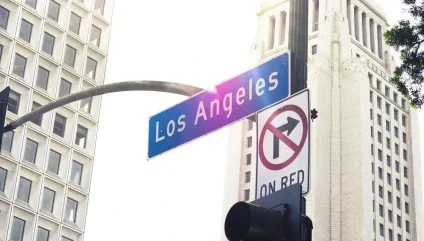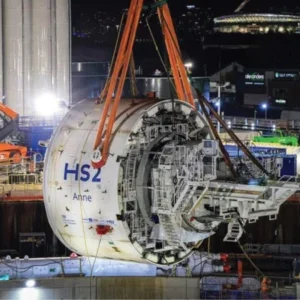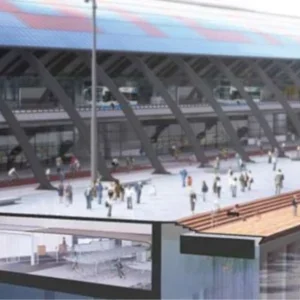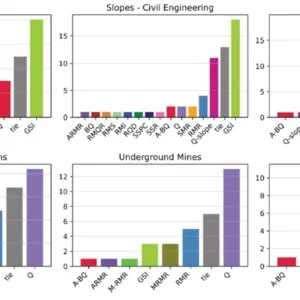
Carlos Herranz began by first explaining that the term sequential excavation method (SEM) is the North American designation for sprayed concrete lining (SCL). He went on to highlight that the Los Angeles area has a long history of underground gas leaks, and that a methane gas explosion in the Fairfax district in 1985 led to the cancellation of plans of expanding the LA Metro at the time.
Since then, additional mitigation measures, such as integrating gas monitoring into construction planning and the use of high density polyethylene (HDPE) membranes have allowed the successful construction of the Purple Line extension in the same area today. The Regional Connector Transit Corridor (RCTC) project of which the presented cavern is a part of has also been constructed in potentially gassy ground.
Having given an overview of the presentation structure, Herranz explained the purpose of the RCTC project. Once becoming operational in 2022, it will close a gap in the metro system in downtown Los Angeles and will allow a direct connection between East Los Angeles and Santa Monica and Long Beach. The project is therefore a key element in improving mobility.
The project includes three stations, a twin-bore tunnel, a section of cut-and-cover tunnel, and the SEM cavern east of 2nd St/Broadway station which was the subject of this presentation.
In 2014, the project was awarded to Regional Connector Constructors, a Design & Build (D&B) Joint Venture (JV) between Skanska and Traylor Brothers, with Mott MacDonald (MM) as the design lead. The project budget is US$1.8bn.
While the use of building information modelling (BIM) is common on UK projects, it is less prevalent on transportation projects in the US. The RCTC project signals the first use of BIM on an LA Metro project, leading to mandating its use on follow-up projects, such as LA’s Purple Line metro.
Herranz illustrated the local constraints leading to the selection of a mined option for construction of the crossover cavern. The crossover is located between a historic building and the LAPD headquarters, next to the offices of the LA Times newspaper. Further, the available space is constrained by the presence of a storm drain and basement structures within the potential footprint of the cavern.
The local ground conditions comprise around 2m of artificial fill overlying about 4m of alluvium. Below these strata lies the clay sandstone of the weathered Fernando Formation, followed by the fresh Fernando Formation in which the cavern is located. Local ground water levels are within the alluvium, however the Fernando Formation is quite impermeable and therefore reasonably dry.
Compared to the reference design, the ventilation was changed from below track level to above track level with a ventilation plenum slab supported on inclined corbels. While this allowed for a better structural shape, the horizontal span of around 17m and a maximum height of roughly 11m still lead to a relatively flat structure.
After giving an overview of the key parameters of the project and the requirement for an HDPE membrane to seal against both water and gas, Herranz presented the challenging requirement of achieving a maximum settlement control of 12.7mm in the buildings above.
The construction sequence for the caverns was defined by the drive sequence of the bored tunnels.
While the initial design was based on a single TBM drive through the cavern leading to a single sidedrift construction staging, programme considerations resulted in a late stage change of concept where both TBM drives were taken through the planned cavern before starting the SEM. This resulted in a twin side-drift and one centre drift configuration. The round length for the cavern, at 1.01m, was shorter than the ring length of the bored tunnel at 1,524mm. The side drifts were excavated in top heading and bench around the bored tunnel, including its demolition, whereas the centre drift was separated into a separate top heading excavation, with the subsequent bench/invert excavation followed by the demolition of the side-drift walls. The design assumption was demolition following closely the bench and invert, but in construction demolition of the sidewalls was allowed to happen later.
The design of the lining follows a double-shell approach, with a temporary 304mm, 34.5MPa (12in 5,000psi) shotcrete lining, and a secondary cast-inplace 457mm 27.6MPa (18in 4,000 psi) concrete. The design was undertaken with a series of 36 2D sensitivity analyses to identify the preferred construction sequence, followed by a detailed 3D Finite Element (FE) model which explicitly modelled the pipe arch to protect the initial 20m of excavation from the station.
The pipe arch was initially intended to provide pre-support and to limit surface settlements, even considering its use throughout the whole length of the cavern. However, due to the size ratio between the excavation and the length of the pipe arch, the benefit for limiting surface settlements was not as great as expected, and it was decided to restrict it to the beginning of the excavation. Generally, the pipe arch appeared to be better suited to control face stability than limiting settlements.
As typically specified in the area, seismic analysis was split into an operational design earthquake (ODE) with a return period of 150 years, and a maximum design earthquake (MDE) associated with a 2,475-year return period. The differentiation is in terms of performance requirements for the completed asset: whereas the trains have to remain operational for the ODE and the structure has to respond in an elastic manner, for the MDE the structure must not collapse but plastification is allowed.
The seismic approach followed a multi-stage methodology with increasing complexity, from free-field 1D analysis returning soil response only via pseudostatic 2D FE approaches which can model soil structure interaction, to full 2D dynamic analyses using time/ history deformations. The cavern was analysed with a full time/history dynamic analysis to account for the interaction between primary lining, secondary lining, and the internal plenum slab relative to the main lining. The plenum slab is supported on corbels. The cavern lining is modelled with elastoplastic elements with plasticity limits discretely and locally assigned – this allowed continuous calculation runs when plastic hinges formed under MDE.
Four different configurations of primary and secondary linings were analysed, including a seismic case where the temporary lining would still be assigned its ground loads and the secondary lining picking up the incremental seismic loads. This specific configuration was reviewed in addition to the client-specified base combinations to ensure the governing case for the lining design was included.
Interestingly, it was not possible to identify a single ‘worst case’ configuration governing the design of the tunnel’s full circumference. Only when primary and secondary lining were considered in combination in a seismic case was yielding in the secondary liner observed. Herranz explained that the numerical model suggested that the reason was that axial force is retained in the primary lining and is not available for compressing the secondary liner, thus avoiding yielding.
As a post-processing check, the yielded sections had to be further analysed to ensure ductility criteria (rotations and strains) derived from codes are satisfied.
Furthermore, a ‘gap’ analysis was undertaken to assess the plenum slab support at the corbels, including whether the plenum slab loses support.
Herranz highlighted the benefits of early contractor involvement in the design as this allowed design development in line with the contractor’s preferred means and methods. The Required Excavation and Support Sheet process, typical of SCL construction, was implemented on the project, and could be prototyped on smaller project-related SCL structures, including a tieback removal shaft, adit and three cross passages.
This ramp-up phase allowed a level of familiarity and trust to be established, making the main, more complex excavation run more smoothly.
Herranz presented photographs showing typical excavation stages. Rebar was introduced only for temporary sidewalls and in some corners.
A steel pile was encountered during the bored tunnel excavation under the LAPD basement. The position of the pile could be proved by use of the pipe screen, which confirmed the existence of two further steel piles. These were exposed with a pocket excavation, cut, and separated from the primary lining with a Styrofoam layer which was then sprayed over.
Herranz highlighted the flexibility of SEM which allows modification of the planned excavation sequence. For example, the contractor proposed extending the round length around the excavation of the bored tunnel lining to 5ft (1,525mm) based on the observed monitoring results which indicated lower than expected settlements.
Next, Herranz presented the excavation of the centre drift invert. A further successfully-implemented contractor proposal was to replace the sprayed invert for the primary lining with a cast-in-place invert, which was possible (and successful) due to the flatness of the geometry at this point. A further modification was to demolish the centre drift walls asymmetrically one after another – a contractor-proposed change which was successfully trialled and implemented for the remaining works.
As the cavern was deemed a higher-risk item, automated total stations were used in combination with extensometers. The monitoring information was collated in a database and presented in specific plots for the RESS meetings. The settlement prediction was close to the observed behaviour: the predicted volume loss was about 0.3%, with the actual value between 0.2% and 0.3%.
Herranz finished by summarising the relevance of the project for the owner as the largest cavern ever built by LA Metro. The benefits of the design-build approach in this situation allowed a flexible development and improvement of the design. This was successfully built, and the observed deformations closely matched the predicted values. A high level of confidence was achieved by the seismic design which assured the complex interaction between soil, primary lining, secondary lining, and internal structures.
Questions and Answers
Following the lecture, Carlos Herranz took questions from attendees. Below is a report on the Q&A, edited and abbreviated for clarity and space.
Q: Mike McConnell, (retired from Balfour Beatty): With the Design & Build form of contract and much communication needed with many parties, how did that work practically, and were there sufficient resources and structures to communicate well on a shift-to-shift basis, such as during night shifts?
Carlos Herranz (CH): On site there were inspectors for the client, the construction managers, and the contractor has its own hired specialists. The design consultant was informed as necessary and available if needed but otherwise was not on site continuously. All parties needed to make decisions were available as required.
Q: David Hindle, (retired from OTB): With eccentric loading in the design of the cavern lining from seismic activity, the question becomes why, more generally for SEM design, is the primary lining considered to completely deteriorate and have no effect on the secondary, permanent lining? Past discussions in Europe about SEM, which Austrian’s called the New Austrian Tunnelling Method (ATM), offered no satisfactory explanation. Wouldn’t patchy deterioration of the primary lining, and perhaps also attack by groundwater, cause some eccentric loading onto the permanent lining?
CH: It is true that once you lose the connection somewhere that continuity of having a whole closed shell working is lost. It is a challenge for modelling.
Q: Any problems for top connections of the temporary walls of the side drifts when using lattice girders?
CH: No problems, neither when at the demolition phase of the temporary walls. In the cavern there were not only lattice girders but local use of rebar, which is still a common practice in many parts of North America. They are used for shape control and not considered from a structurally in the initial lining design.
Q: NN: Please elaborate on flashcreting the invert.
CH: The contractor did not use shotcrete for the centre drift but used cast-in-place concrete instead. The contractor found it better for them. Our main concern was with geometry that with a slight curvature to the invert there would be good connection with the side drifts that had been constructed previously with shotcrete. There was no problem.
Q: Would considering the ongoing forest fires lead to changes in the design?
CH: As the fires are away from downtown LA where the project is situated no change in the design would be envisaged.
Q: John Clark-Hughes (Jacobs): If you were to undertake the project today, is there anything you would do differently, any innovations or lessons?
CH: There could be consideration of not using lattice girders, as in the practices of more mature SEM/SCL markets, like UK. Also, we could investigate, or consider, if the initial lining can only work in the temporary case and what is its relationship to the permanent condition. There are limitations to such, due to the seismic design in LA, but perhaps there could be some thought given to the potential for optimising the lining in that aspect. In Crossrail there are examples of initial lining being used as part of the permanent structure.
Q: Toby Loxley (OTB Engineering): What factors were taken into account for appraisal of the changed geometry of the cavern, and who drove the design change?
CH: Change driven by the designer side. It needs to be noted that the Reference Concept Design was only an option on the project – conceived on the basis it might happen or it might not. The design was possibly not able to be developed a lot. We thought right away that we could not work with such a flat profile for the crown and addressing that point was one of the first things we did on the design side. The contractor did not have so much input. But the change also brought a better ventilation solution by having the ducts at the top of the cavern instead of below the track level.
Q: Shani Wallis: Is the method now an approved method for LA metro? Is it being adopted for mined stations on their future lines and other clients in the LA area?
CH: Not aware of plans for other such mined underground stations at present. But the project is a good reference experience to inform planning options of future projects.
Q: Thomas McGowan (Bedi Engineering): Regarding concrete compressive strengths, the primary lining of the cavern was 34.5MPa (5000psi) and secondary 27.6MPa (4000 psi), which seems slightly on the lighter side compared to projects in London. Are those typical of North America and was there any durability-related conformance testing done on the project?
CH: The question comes up a lot and the levels were also a surprise at the beginning. The level on the project is sort of at a lower level for the permanent lining where it is more usually like 30MPa. But it is relatively typical for the area.
Another project being worked on in California has a similar level, or allowance, for the strength. The contractor could propose to have a higher strength, as could have happened for RCTC. On durability, there was no issue. But it was noted that UK practice does have higher strength for the permanent structure.
Q: Kate Cooksey: What was learned from the practise trial runs with smaller structures that perhaps changed how to do things differently for the large cavern?
CH: There was nothing different in terms of design. But there were improvements in processing monitoring data and preparing information for formal project management meetings and communications. The early experience of the trail runs also helped the contractor obtain good data for shotcrete testing. Overall, though, there were no major design or construction changes for the large cavern as a result of the early works.






